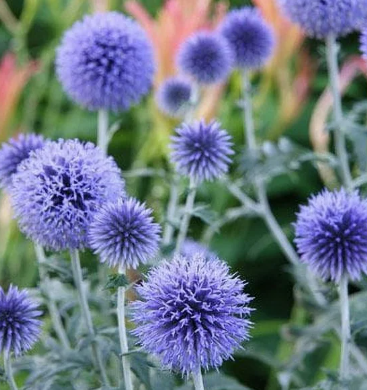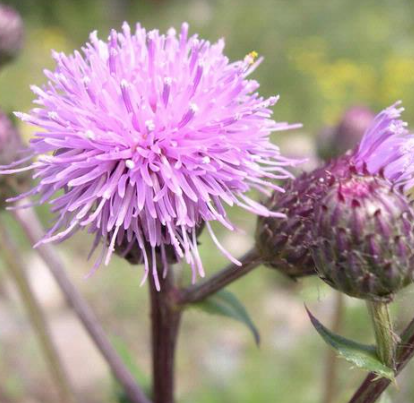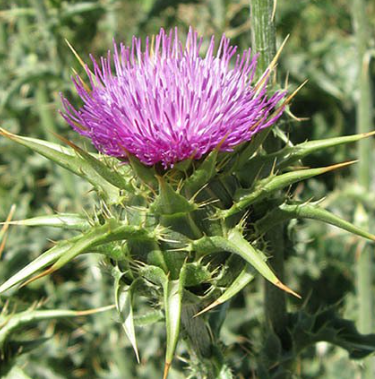Globe thistle, Canada thistle, Milk thistle, and Star thistle
Introduction
Thistle is the common name of a group of flowering plants characterized by leaves with sharp prickles on the margins, mostly in the family Asteraceae. Prickles can also occur all over the plant – on the stem and the flat parts of the leaves. These prickles are an adaptation that protects the plant from being eaten by herbivores. Typically, an involucre with a clasping shape similar to a cup or urn subtends each of a thistle's flower heads. The typically feathery pappus of a ripe thistle flower is known as thistle-down.
Globe thistle

The Globe thistle is a fast-growing, contemporary-looking flower with old-world qualities. The many small, blue flowers that make up the round head of Globe Thistle are very attractive to bees and butterflies. It is easily grown in various soils but must be well-drained and not too fertile. The Blooms appear mid-summer through September, and the gray-green hairy leaves are also attractive. The plant is tolerant of drought, deer, and rabbits. Use in the back of the perennial border. Yet unlike other eye-catching perennials, globe thistle is drought tolerant, deer resistant, and an important nectar source for butterflies and bees. While uninviting to rabbits and deer, the spiny, spiky foliage of globe thistle is important in the garden as a host plant for the finicky painted lady butterfly.
Canada thistle

Canada's thistle is native to Europe. It was introduced to North America in the 1600s, probably in agricultural seed shipments, and is widespread throughout the United States and Canada. Canada thistle is a widely distributed perennial plant that can grow up to five feet tall. Its leaves have sharp spines along the edges. Canada thistle grows in various habitats with full or partial sun and is often found in disturbed areas such as roadsides, trails, pastures, and recently flooded areas.
Star thistle

Sea holly plants (star thistle) are low-maintenance perennials with basal clumps of dark green leaves that produce taller flower stems with striking purple-blue flowers that look like small glowing thistles from midsummer until fall. Native to Europe, sea holly flowers have green or blue cones and a distinctive bract collar in silver, white, green, or bluish-purple. The colors have a painted-on, metallic sheen that changes in the sunlight, and their stems can be green or silvery blue, depending on the variety. Spring is the best time to plant mature plants—sea holly will grow quickly, and semi-mature nursery plants will flower in their first season. Sow seeds in late summer or fall, and they'll germinate in spring. Once established, these are long-lived perennials.
Milk thistle

Milk thistle is native to Europe and was introduced into North America by early colonists. Milk thistle is found throughout the eastern United States, California, South America, Africa, Australia, and Asia. “milk thistle” and “silymarin” are often used interchangeably. Milk thistle is a plant named for the white veins on its large, prickly leaves. Shiny green leaves have distinct white marbling patterns and spines on leaf edges and stems. In April-October, pink-purple flower heads, with broad, spiny bracts at their bases, appear singly at stem ends. Reproduces via seeds that persist in the soil for at least 9 years. Historically, people have used milk thistle for liver disorders and gallbladder problems. Milk thistle is promoted as a dietary supplement for hepatitis, cirrhosis, jaundice, diabetes, indigestion, and other conditions.


